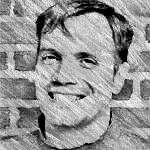Geoffrey Barrows
Some of the most profound technological inventions take their inspiration from what is found in nature. Such is the case with the innovative optic-flow sensors developed by engineer and inventor Geoffrey Barrows. The sensors are designed to allow both aerial and ground vehicles to travel autonomously, by using the same techniques living creatures, such as flying insects, do to gauge their altitude and proximity to obstacles in their path.
Barrows was born in California in 1970. As his father was a career officer with the U.S. Air Force, his family moved often, with stops in Massachusetts, New York, Alabama, and Nebraska, as well as in Germany, where Barrows spent six years as a pre-teen before the family settled in the outskirts of Washington, D.C.
He enrolled at the University of Virginia as an electrical engineering major where he first became interested in neural networks. He changed his focus to applied mathematics when he noted that much of the published research on neural networks involved complex equations. He became familiar with the concept of optic flow in a psychology class called “Theories of Perception” and was immediately intrigued.
Optical flow refers to the apparent visual motion you experience as you move through the world. As Barrows explains, suppose you are looking out the window of a car or a train. You see trees, the ground, buildings, etc., that all appear to move backwards. This motion is optic flow. This motion can also tell you how close you are to the different objects you see. Distant objects like clouds and mountains move so slowly they appear still. The objects that are closer, such as buildings and trees, appear to move backwards, with the closer objects moving faster than the distant objects. Very close objects, such as grass or small signs by the road, move so fast that they whiz right by you.
There are clear mathematical relationships between the magnitude of the optic flow and where the object is in relation to you. If you were an insect, for example, flying forward down the center of a hallway, the optical flow on the left and right walls will be equal to each other. If you’re too close to one wall, that wall will appear to move faster, i.e. have a faster optical flow. If you want a simple rule to follow to make sure that you stay in the center, all you have to do is to move away from the faster moving wall until the left and right optical flows are the same. This will put you at the center of the wall.

Barrows began working as an undergraduate research assistant in a neuroscience lab where research focused on learning mechanisms in the area of the brain called the hippocampus, an area responsible for short-term memory, map building, and other functions. He joined a group within that lab that assembled computer models of the hippocampus using biologically inspired neural networks. He began experimenting with those models to identify pattern sequences, using his love for dance and music as inspiration to ask questions on how neural network structures could learn rhythms and other time-varying patterns. He became fascinated with the idea of using neural network patterns to solve real-life problems – which led him to believe he was more suited to becoming an engineer than a research scientist. He completed his BS in Applied Mathematics at the University of Virginia in 1993 and moved on to Stanford University, where, a year later, he earned an MS in Electrical Engineering.
From there Barrows began working with the Naval Research Laboratory in Washington, D.C. as a Research Engineer. At the same time, he enrolled as a doctoral student at the University of Maryland, College Park, where he completed his PhD in 1999. From 1995 to 1996 he worked on a project involving the use of biologically inspired neural network algorithms for classifying radar signals. Later, while considering possible dissertation topics, he became interested in an effort backed by DARPA – the Defense Advanced Research Projects Agency – to build "micro air vehicles" with wingspans of up to 15 centimeters. He noted that while many were intrigued by the idea of building the vehicles themselves, or power supply and control structures, very few people were interested in navigation. Barrows saw this as an opportunity to use the optic flow concepts and biologically inspired neural networks structures he had studied as an undergraduate. He set to work immediately on developing a sensor that would endow these aircraft with insect-like depth perception.
He dove into the academic literature on how insects navigate through the world and honed in on biologically inspired computation and sensing. Within a couple of years, he had a prototype of a sensor that measures optical flow in a very compact and lightweight package. He produced the first demonstrations in 1999 and 2000. That year he left NRL to start Centeye, Inc. to commercialize the technology. With support from DARPA, he continued to work on the technology and to develop new, related projects. Centeye began selling the sensors in 2005, and the company continues to improve the technology in a number of projects today. Barrows aims to make the sensors as lightweight (less than 1 gram) and as inexpensive as possible for use in both military and consumer robots, such as unoccupied aerial vehicles (UAVs), robots, and toys.
Barrows holds over six patents for his technology. In 2003, he was named to Technology Review’s TR100, a list of 100 of the world’s top innovators under age 35.


